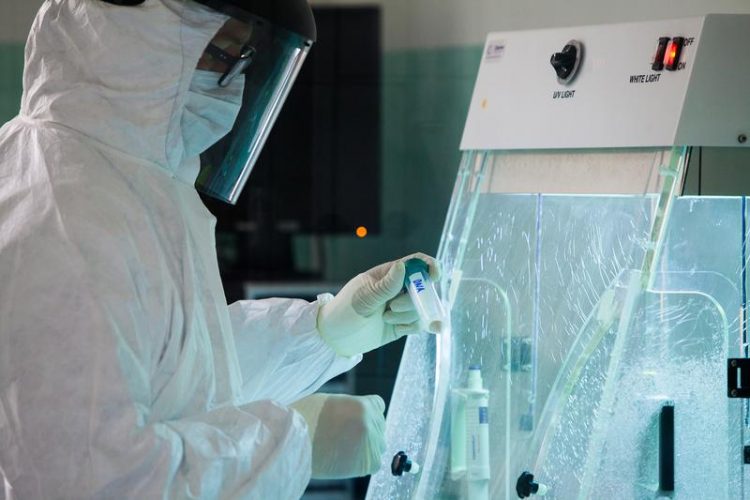Ötzi’s “non-human” DNA

Frank Maixner (EURAC) Photo: EURAC
However the tiny sample weighing no more than 0.1 g provides so much more information. A team of scientists from EURAC in Bolzano/Bozen together with colleagues from the University of Vienna successfully analysed the non-human DNA in the sample.
They found evidence for the presence of Treponema denticola, an opportunistic pathogen involved in the development of periodontal disease. Thus, by just looking at the DNA, the researchers could support a CT-based diagnosis made last year which indicated that the Iceman suffered from periodontitis. The results have been published in PLOS ONE.
Much of what we know about Ötzi – for example what he looked like or that he suffered from lactose intolerance – stems from a tiny bone sample which allowed the decoding of his genetic make-up. Now, however, the team of scientists have examined more closely the part of the sample consisting of non-human DNA.
“What is new is that we did not carry out a directed DNA analysis but rather investigated the whole spectrum of DNA to better understand which organisms are in this sample and what is their potential function”, is how Frank Maixner, from the EURAC Institute for Mummies and the Iceman in Bozen/Bolzano, described the new approach which the team of scientists are now pursuing.
“This ‘non-human’ DNA mostly derives from bacteria normally living on and within our body. Only the interplay between certain bacteria or an imbalance within this bacterial community might cause certain diseases. Therefore it is highly important to reconstruct and understand the bacterial community composition by analysing this DNA mixture,” said Thomas Rattei, Professor of Bioinformatics from the Department of Microbiology and Ecosystem Science at the University of Vienna.
Unexpectedly the team of scientists, specialists in both microbiology as well as bioinformatics, detected in the DNA mixture a sizeable presence of a particular bacterium: Treponema denticola, an opportunistic pathogen involved in the development of periodontitis.
Thus this finding supports the computer tomography based diagnosis that the Iceman suffered from periodontitis. Even more surprising is that the analysis of a tiny bone sample can still, after 5,300 years, provide us with the information that this opportunistic pathogen seems to have been distributed via the bloodstream from the mouth to the hip bone.
Furthermore, the investigations indicate that these members of the human commensal oral microflora were old bacteria which did not colonise the body after death.
Besides the opportunistic pathogen, the team of scientists led by Albert Zink – head of the EURAC Institute for Mummies and the Iceman – also detected Clostridia-like bacteria in the Iceman bone sample which are at present most presumably in a kind of dormant state. Under hermetically sealed, anaerobic conditions, however, these bacteria can re-grow and degrade tissue. This discovery may well play a significant part in the future conservation of the world-famous mummy.
“This finding indicates that altered conditions for preserving the glacier mummy, for example when changing to a nitrogen-based atmosphere commonly used for objects of cultural value, will require additional micro-biological monitoring,” explained the team of scientists who will now look closer at the microbiome of the Iceman.
http://”http://www.plosone.org/article/info%3Adoi%2F10.1371%2Fjournal.pone…. – article in PLOS ONE”
Media Contact
All latest news from the category: Life Sciences and Chemistry
Articles and reports from the Life Sciences and chemistry area deal with applied and basic research into modern biology, chemistry and human medicine.
Valuable information can be found on a range of life sciences fields including bacteriology, biochemistry, bionics, bioinformatics, biophysics, biotechnology, genetics, geobotany, human biology, marine biology, microbiology, molecular biology, cellular biology, zoology, bioinorganic chemistry, microchemistry and environmental chemistry.
Newest articles

A universal framework for spatial biology
SpatialData is a freely accessible tool to unify and integrate data from different omics technologies accounting for spatial information, which can provide holistic insights into health and disease. Biological processes…

How complex biological processes arise
A $20 million grant from the U.S. National Science Foundation (NSF) will support the establishment and operation of the National Synthesis Center for Emergence in the Molecular and Cellular Sciences (NCEMS) at…

Airborne single-photon lidar system achieves high-resolution 3D imaging
Compact, low-power system opens doors for photon-efficient drone and satellite-based environmental monitoring and mapping. Researchers have developed a compact and lightweight single-photon airborne lidar system that can acquire high-resolution 3D…





















